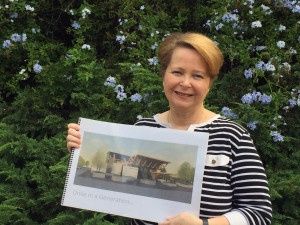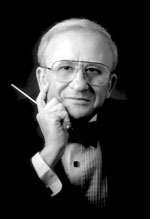
By Donald H. Harrison

SAN DIEGO –“‘Give me liberty or give me death,” said the American Revolutionary War orator Patrick Henry. “And, while you’re at it,” add community members at the high school named after him, “give me a decent performing arts center too!”
Since Patrick Henry High School’s construction in 1968, its students have had to do without a bonafide auditorium, settling instead for something known as a “cafetorium.”
“Another name for it might be the ‘auditeria.’ quipped David Amos, the conductor of the Tifereth Israel Community Orchestra, one of the arts groups in the community backing a campaign to build the Patrick Henry Arts, Media and Entertainment (PHAME) Center with an orchestra pit, and elevated seating for a 505-member audience.

Amos has a sentimental reason for wanting to see Patrick Henry students get an “auditorium” worth its name. More than four decades ago, he served as the first music teacher at the high school and he can still remember with a shudder the disadvantages that the “cafetorium” — that is a cafeteria with a small stage at one end– presented for his music students.
The room’s floor had to be perfectly flat because it was used as the school’s cafeteria during the day, so, of course, it couldn’t be sloped to permit all members of the audience to have a view of the stage at the end of the room, Amos recalled “The ability for rehearsals was totally dependent on the lunch schedule” and the stage was too small to permit students to do musical theatre.
“In general, it hampered the progress of a very active music and drama program that could have used a real auditorium,” he said.
Katherine Nakamura, a former San Diego School Board member whose son William is an award-winning tuba player about to graduate from the high school, has been leading the drive to build the PHAME center. The drive is approximately $1 million short of its $13.6 million goal.
She said she was on the school board in 2008 when she and her husband Kotoro, an architect, went to hear William play his first year in the school orchestra. Barely had they settled into rickety folding chairs from which they had to crane to get a view of William when Kotoro “began hissing at me,” in essence, scolding her for permitting a school to have such an inferior facility. In her defense, Katherine Nakamura said that up to that point she hadn’t been apprised of Henry’s woeful lack of facilities.
The cafeterium, she said, “is just hideous. It has linoleum floors, the acoustics are horrible, it has a big Jack n’ Jill accordion divider in the middle of the room, it is sweltering hot in there, and it has the smell of a cafeteria.”
Only two San Diego high schools — Patrick Henry and Samuel Morse — were built without auditoriums, the thinking in 1968 being that they could hold performances outdoors, Nakamura said. In the eastern portion of San Diego, where Patrick Henry is located, it is often too hot during the day and too cold at night to make the outdoor amphitheatre practical.
During her term of office, Nakamura helped pass a $2.1 school construction bond issue — Proposition S of 2008 — to render aid to elementary, middle and high schools across the 200-square-mile district. Patrick Henry got some of the money, but not enough to finance a performing arts center. Morse High School chose to use the money for other purposes.
So important is PHAME to the cluster of eight elementary schools and two middle schools that feed into Patrick Henry High School, that each of them contributed a portion of their Proposition S funds to have the center built, Nakamura said. Patrick Henry and the ten other schools currently serve a total of 8,154 students.
The community also was able to persuade state officials that PHAME was eligible for career technical education funds because the entertainment and music industries are where many Californians work.
“Southern California is the home of the Emmy, the Grammy, and the Oscar, and vocational training in Califorbia needs to include not just the actors on the stage and the musicians, but also the cameramen, the directors, the stage designers, entertainment attorneys, and music publishers…. This is an industry that goes all the way from Santa Barbara to Rosarito (Mexico),” she said.
In a reversal of school district policy, high schools that were built after Samuel Morse and Patrick Henry included real auditoriums. Nakamura suggests that put the students who had to perform in the cafetorium at a disadvantage when they applied for admission to college.
She explained: “We (Patrick Henry) send too many kids to two-year colleges; we could be sending more to four-year colleges.There are three legs on the application to college — GPA (Grade Point Average), SAT (Scholastic Aptitude Test) and extracurricular activities, what you participate in. I have spoken to a number of students who feel that they are at a severe disadvantage because they don’t have this facility.”
Not only the drama and music students are affected, she said. “There’s also the speech and debate clubs, the Model United Nations, and other groups that could use a facility like this.”
With $12.6 million already assured, and such fundraising activities underway as a May 21 golf tournament at Admiral Baker Field, Nakamura says it’s no longer a question of whether the facility will be built but what equipment and accoutrements it will come with.
Will there be concrete floors or rugs? Will there be comfortable chairs to watch the performances in? Will it be a facility in which the community can take pride? Nakamura says the response to the fundraising campaign will answer these questions.
Located on Navajo Road near Cowles Mountain, Patrick Henry High School serves students from the San Diego communities of San Carlos, Del Cerro and Allied Gardens. With a sizeable Jewish population nearby, the drive for PHAME has attracted the attention of some prominent community members in addition to Amos. They include television broadcaster Paul Bloom, State Assemblyman Marty Block, City Councilmember Marti Emerald, former School Board Member Sue Braun and City Council candidate Mat Kostrinsky.
*
Harrison is editor of San Diego Jewish World. He may be contacted at donald.harrison@sdjewishworld.com
Pingback: Kostrinsky says council members should mediate disputes | San Diego Jewish World
Pingback: SD Jewish World – Cowles Mountain Community Foundation